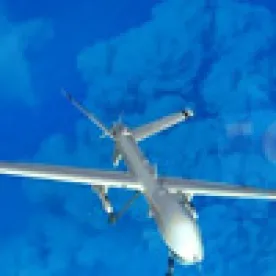Drones – or, in Federal Aviation Administration parlance, Unmanned Aircraft Systems (“UAS”) – are proliferating everywhere. In the past few weeks an unmanned drone landed on the White House grounds and the federal government had to issue warnings not to fly drones over the Super Bowl. The energy industry has already begun to exploit UAS’s potential for enhanced efficiency and safety. Likewise, governments are finding ways to use drones to further their monitoring and enforcement efforts. It promises to be very interesting times.
This blog will focus on the use of drones in the energy industry and the FAA’s upcoming proposed regulations governing UAS usage.
Current Federal Policy on Drones
Over the past few years, energy companies operating both onshore and offshore have increasingly looked to the use of UASs in their operations. Among other things, UASs can be used to inspect long stretches of isolated pipelines or other assets in remote areas, and they can help monitor spills during response actions, monitor oil rig flare stacks, and track wildlife for avoidance purposes. Not only are they efficient, UASs enhance safety by reducing the need for employees to access risky locations. Drones in this context may give new meaning to the phrase “energy efficiency,” especially as the energy industry is contracting after the plunge in oil prices.
While subject to much debate over the past few years, the FAA has jurisdiction over UASs and approves their use on a case-by-case basis. In 2013, the FAA issued restricted category type certificates to a pair of UASs to be used for commercial purposes off the Alaska coast. ConocoPhillips used those UASs to perform ice and marine mammal surveys necessary before drilling. Then, in June 2014, the FAA approved the first commercial UAS flights over land. The June 2014 approval addressed a request by BP to use UASs to survey pipelines, roads and equipment in Prudhoe Bay, Alaska, the largest oilfield in the U.S. And just in the past few weeks, the FAA has granted regulatory exemptions that would allow the use of UASs for inspection of oil and gas flare stacks.
Currently, companies looking to conduct UAS operations are using the Special Airworthiness Certificate process and may file a petition for an exemption under Section 333. Once an application is received, the FAA will conduct a comprehensive operational and technical review that can span months. The process includes an opportunity for public notice and comment, which means the FAA will need to address any opposition. In the end, FAA may issue an approval via a “Grant of Exemption” from obtaining a Special Airworthiness Certificate. That is the process now, which can take as long as six months. All that may change once the FAA implements its new regulatory program.
FAA Regulations for Small Drones
The 2012 Federal Aviation Administration Modernization and Reform Act called on federal agencies to develop a comprehensive plan to accelerate the integration of civil UAS into the National Airspace System (“NAS”). One component of that plan included a rulemaking to (1) define the acceptable standards for operation and certification of civil UAS; (2) ensure that any civil UAS includes a sense-and-avoid capability; and (3) establish standards and requirements for the operator and pilot of a civil UAS, including standards and requirements for registration and licensing.
Later this year, the FAA is expected to take a step in implementing this plan by proposing rules for the operation of small UAS (“sUAS”) in the NAS. The proposed rulemaking is currently at the White House Office of Management and Budget (“OMB”), which is the last step before the proposal is released. The proposed rulemaking will likely address the classification of sUAS, certification of sUAS pilots and visual observers, registration of sUAS, approval of sUAS operations, and sUAS operational limits. The proposal is also expected to include regulations for all sUAS, including operating standards for model aircraft and low performance (e.g., toy) operations, to increase the safety and efficiency of the NAS. A major component of the proposed rule will be the regular collection of safety data from the user community to assist FAA to develop new regulations and expand sUAS access to the NAS.
Final Thoughts
The expansion of the UAS market is inevitable, and the use of this technology by the energy industry will only increase. That being said, there are challenges ahead. The current approval process will soon give way to a new regulatory program. Companies that plan to market their UAS technology to the energy industry as well as companies planning to use UAS in their operations will need to follow regulatory developments closely. Beyond the FAA, many states have enacted legislation applicable to drones and UAS, which could provide another layer of requirements and potential confusion.





 />i
/>i

